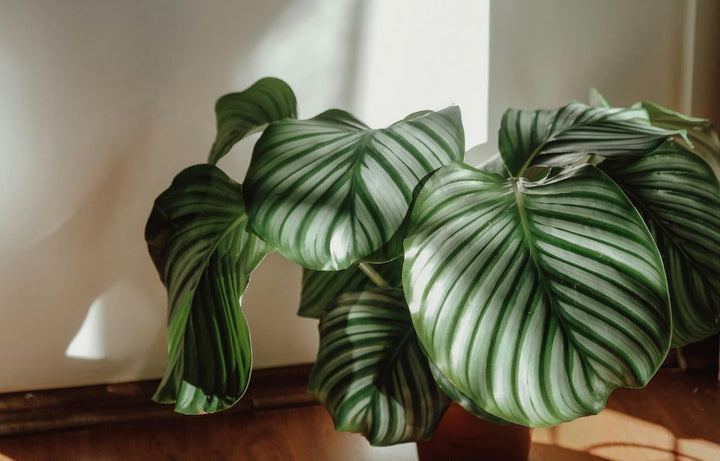
Plant Profile: Calatheas - A Fantastic Indoor Plant
Plant Profile: Calatheas - A Fantastic Indoor Plant
Among the vast array of indoor plants, Calatheas Plants stand out with their vibrant foliage and unique patterns. Originating from the tropical regions of South America, Africa, and Southeast Asia, Calatheas are renowned for their stunning foliage, characterised by intricate patterns, bold stripes, and vibrant colours.

Calatheas belong to the Marantaceae family and are native to rainforests, where they thrive under the canopy of trees with filtered sunlight and high humidity. Their native habitats include regions in South America, Africa, and Southeast Asia, where the climate is warm and tropical.
While Calatheas have specific care needs, they are generally considered low-maintenance compared to some other tropical plants. Their water and humidity requirements are manageable with proper attention, making them suitable for plant enthusiasts with varying levels of experience.
Pet and children safe: While the leaves pose a choking hazard if ingested excessively, Calathea plants are generally considered to be non-toxic nor harmful to most humans and animals. However, those sensitive or allergic to certain plants, ensure safety with close monitoring for allergies and place plants in less accessible areas.
Varieties of Calatheas
Calathea plants are a diverse group of plants with numerous varieties, each with its own unique foliage patterns and characteristics. Here are some popular varieties of Calathea:
- Calathea orbifolia: Known for its large, round leaves with silver-green stripes and a striking overall pattern.
- Calathea lancifolia (Rattlesnake Plant): Features long, lance-shaped leaves with dark green spots and a distinctive rattlesnake-like pattern. The Rattlesnake Plant is one of the most popular indoor plants.
- Calathea zebrina (Zebra Plant): Recognized for its bold zebra-like stripes on the leaves, alternating between dark green and light green. The Zebra Plants is doesn't like too much light but it's one of the most interesting plants.
- Calathea medallion: Characterized by its round leaves with a bold, dark green pattern in the center and lighter green along the edges.
- Calathea ornata (Pinstripe Calathea): Showcases pink stripes along the midrib of its leaves, contrasting with the dark green background.
- Calathea makoyana (Peacock Plant): Features intricately patterned leaves with a mix of green, cream, and pink, resembling a peacock's feathers. Hence the name, Peacock Plant.

Caring for Calatheas
Light: Calatheas have a unique ability to move their foliage, and open and close their leaves in response to too little or too much UV or natural sunlight. Although this allows them to moderate light intake, Calatheas prefer bright, indirect light.
While they can tolerate lower light conditions, they may not display their characteristic vibrant colours. However, avoid exposing them to direct sunlight, as it can scorch their delicate leaves. A spot near a north or east-facing window is ideal.
Temperature and Humidity: Maintain a consistent temperature between 18-24°C and provide high humidity. Calathea plants thrive in environments with humidity levels above 50%, making them perfect for bathrooms or kitchens. Regular misting or placing a humidifier nearby can help create the optimal conditions.
Watering: Keep the soil moist but not waterlogged. Watering when the top inch of soil feels slightly dry is a good rule of thumb. Use distilled or filtered water to prevent mineral buildup in the soil. Calatheas can be sensitive to high concentrations of fluoride and chlorine. Tap water is completely fine to use.
Soil and Potting: Use a well-draining potting mix rich in organic matter. A mix containing peat, perlite, and pine bark works.
Repotting helps refresh the soil and provides the roots with ample space but you should only do this every 2 years or so, and only do so when the plant outgrows its container. The new container should be about one size larger than its current one.
Fertilising: During the growing season (spring and summer), feed Calatheas with a balanced, water-soluble fertiliser every 4-6 weeks. Reduce or stop fertilising in the autumn and winter when the plant's growth slows down.
Propagation: To propagate a Calathea, choose a healthy plant, separate sections with roots and stems, plant them in fresh soil, water thoroughly, and provide suitable care for new growth to thrive. Make sure you use clean cutting tools when pruning Calathea plants. You can even use tap water to get your cutting going.

Common Problems and Solutions
Brown Tips: Brown leaf tips may indicate low humidity. Increase humidity by misting the plant or placing a tray of water near it. Ensure the plant is not exposed to drafts or direct heat sources.
Yellowing Leaves: Overwatering or underwatering can lead to yellowing leaves. Adjust your watering routine and ensure proper drainage to prevent waterlogged soil.
Drooping Leaves: If the leaves are drooping, it may be a sign of underwatering. Water the plant thoroughly and adjust your watering schedule accordingly.
Slow Growth: Slow growth can be due to overpotting or becoming root-bound. Constant repotting can damage the roots which will slow the growth of the plant while it heals itself. Root-bound plants are slow to grow as they are unable to absorb nutrients and water from the soil. Regularly check the soil, and only repot when needed.
Pests: Keep an eye out for common pests like spider mites and scale insects. Wipe the leaves with a damp cloth to remove pests, or use neem oil as a natural insecticide.
Calatheas bring a touch of the tropics into your home, showcasing nature's beauty with their intricate foliage. By understanding their origins and following proper care guidelines, you can enjoy these stunning houseplants and create a lush, green oasis within your living space. Remember to stay attuned to your Calathea's needs, and with a little love and attention, you'll be rewarded with a thriving and visually captivating indoor garden.
